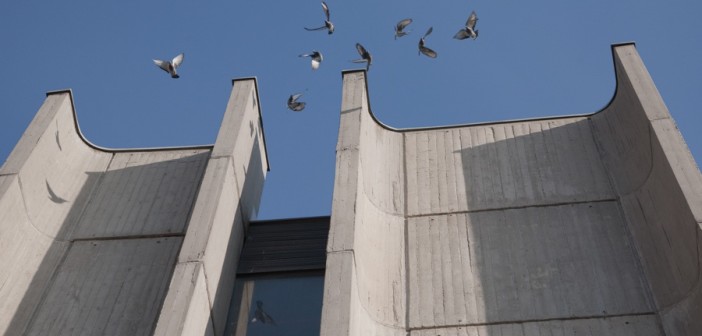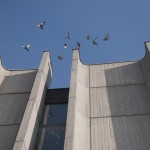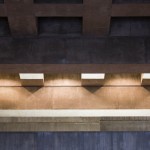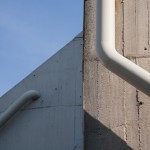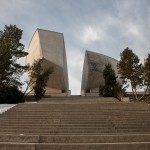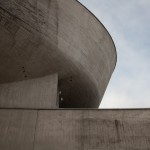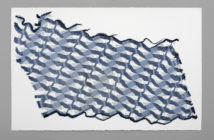Brutalism is arguably one of architecture’s most challenging styles. This mid century aesthetic is typified locally in buildings like Boston’s City Hall, built in 1968, and the campus of Southeastern Massachusetts University (now University of Massachusetts at Dartmouth), which was completed in phases from 1966-1971. These buildings are striking in their richness of texture, complexity of design, and the assertive face they turn to the world. Architects working in the Brutalist mode eschewed the glass curtain walls and cool steel of their contemporaries and embraced structures molded out of concrete that often bore the mark of the wood that formed them. Though fascinating and thought provoking, these buildings are frequently classed as problematic, if not ugly, and have drawn the ire of many.
Despite being beautifully and thoughtfully designed, Brutalist buildings rarely age well. Many of the best examples were government commissions and in the years since they were constructed they have experienced decline due in part to the limited funds budgeted for upkeep. For this reason, even more than for the their design, Brutalist structures are often the target of anger on the part of individuals and communities at large. The fact that they were additionally sometimes tied to insensitive urban renewal programs, as is the case with Boston’s City Hall, only makes matters worse. Brutalist buildings have been in need of an advocate for some time and found one recently in Viera Levitt.
Levitt, the Gallery Director at University of Massachusetts at Dartmouth, presents photographs of these hard to love structures in her show Brutally Sweet at AS220's Project Space in Providence, Rhode Island. Her images are an overt ode to the style she appreciates more than the average viewer. The edifices she images are often described as cold and austere while simultaneously being associated with totalitarianism and urban blight. In Levitt’s imagery, these buildings are finally given their due. Her clean and refined photos do a wonderful job of culling out all the lovely intricacy and beauty that can be found in Brutalist designs. She reconsiders Brutalism for the viewer and in doing so exposes onlookers to the very best the style has to offer to architecture and art alike.
Levitt dedicates several pieces to the upward gaze, an appropriate outlook considering the huge scale of many Brutalist buildings. This size encourages the viewer to peer into the distance ceilings, evincing a literal high mindedness, which made the style ideal for university and government buildings with grand aspirations. Levitt’s images convey the experiential aspect of the spaces she depicts and the awe that their vast monumentality and geometric complexity elicit.
The quality of Levitt’s collection of photographs is enhanced by their vibrant arrangement within the gallery. The show deftly and subtly gives viewers the feeling of being in the world and of experiencing Brutalism from within and without. It highlights Levitt’s images for what they are essentially: architectural views through the eyes of a curious passer by.
The collection is successful because it approaches Brutalism from the high art aesthetic but with a human perspective. With a focus on form from the view of the pedestrian, the artist is able to redefine boundaries and chart a new course of approachability for the Brutalist aesthetic. Through Levitt’s lens, we finally see that buildings do not necessarily have to be very pretty to be very beautiful.
Brutally Sweet is on view at AS220's Project Space at 93 Westminster Street in Providence until June 29.
- Trnava, 2013
- Boston City Hall, 2013
- Trnava, 2013
- Banska Bystrica, Slovakia, 2013
- Banska Bystrica, Slovakia, 2013

